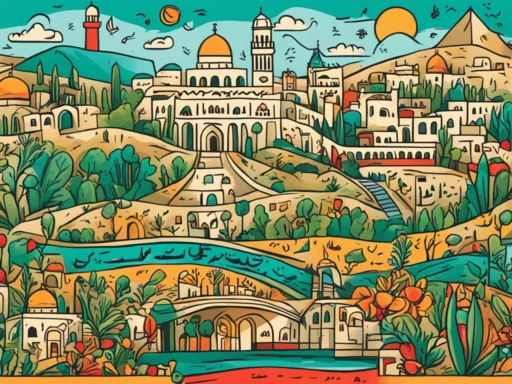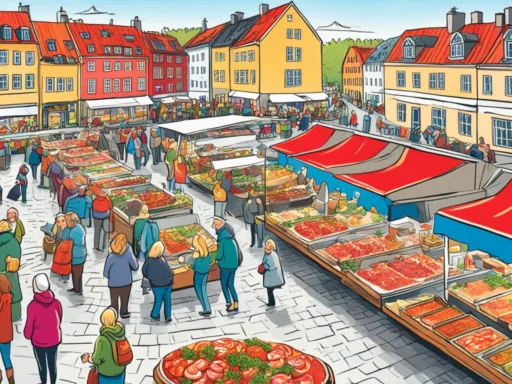Among the tapestry of Europe’s cultures, a startling fact stands out: a single nation, Poland, is home to a wealth of **languages spoken**, stretching beyond its borders and historical influences. While Polish undoubtedly prevails as the chief medium of communication, Poland’s **linguistic diversity** reflects a broader spectrum of tongues than many might expect. This unique blend of **multilingualism in Poland** is not only evident through its predominant language but also through regional dialects and minority voices that resonate through the populous country’s vibrant cities and rustic countryside.
Poland’s linguistic landscape is primarily dominated by Polish, a language that sails under the flag of the West Slavic linguistic fleet. It carries with it the legacy of unity and resilience, changing tides of foreign rulers who sought to dampen its distinct voice. Polish dialects, such as Silesian with its Germanic notes and Kashubian with dwindling speakers, paint Poland’s linguistic picture with more colors than a casual observer might notice at a glance.
Amid this mix, Roman Catholicism has etched a significant influence, intertwining the threads of language and faith into a rich cultural fabric that has withstood the tests of time and political upheavals. Here, language acts as a beacon of national identity, emerging stronger through historical attempts at Germanization or Russification. The heartbeat of Poland reverberates through its native tongue and the chorus of its diverse speech communities, creating a melody of human expression worth exploring.
Key Takeaways:
- Poland’s official language, Polish, is spoken by the vast majority and displays a range of regional dialects.
- The country’s rich linguistic tapestry also includes minority languages and various multilingual communities.
- Historical events have significantly shaped the Polis language and its role in national identity.
- Despite globalization, regional and minority languages in Poland enjoy legal recognition and protection.
- Current language policies in Poland advocate for the inclusion and support of multiple languages in education and official settings.
- Church influence in Poland has, over centuries, played a pivotal role in shaping the nation’s linguistic and cultural landscape.
- Silesian, with its unique blend of Polish and German, stands out as a symbol of the complex linguistic history of some regions.
The Predominance of the Polish Language
The Polish language stands at the heart of communication in Poland, weaving a rich tapestry of cultural heritage deeply rooted in the nation’s history. Literary Polish has evolved over the centuries, enveloping the disparate dialects of its regions to form the cohesive, expressive language that serves as the bedrock of daily life and the main conduit for cultural exchange.
Despite a history peppered with foreign influences and the challenges of cultural assimilation, the resilience of the Polish language fortified its role as a symbol of national identity. This stalwart presence is most vividly captured in the tapestry of dialects that cradle the country’s collective voice, threading from Great Poland to Little Poland and beyond.
The tacit position of the Polish language as one of the official languages in Poland is not without its complexities, particularly in how it has overshadowed some of the country’s minority languages. An illustrative case is that of the Kashubian language. Recognized officially as a regional language, Kashubian represents the enduring legacy of Poland’s ethnic minorities but is spoken by an increasingly sparse population of ethnic Kashubians today.
“The Polish language, enduring through time, is the perennial stream through which the lifeblood of Poland’s culture and identity flows.”
| Language | Status | Number of Speakers | Regions Predominantly Spoken |
|---|---|---|---|
| Polish | Official Language | Approx. 38 Million | Nationwide |
| Kashubian | Regional Language | Approx. 108,000 | Pomerania |
Understanding the linguistic landscape is key to unraveling the social fabric of the nation; thus, recognizing the significance of the official languages in Poland is but the first step in appreciating the diverse voices that compose its identity. The steadfast presence of the Polish language in modern communication is a testament to the nation’s historical prowess and ongoing cultural vitality.
Languages Spoken Poland: A Multicultural Tapestry
The language landscape in Poland is a vivid reflection of the nation’s complex past and its embrace of multiculturalism. While the Polish language predominates, a wealth of communities add to the country’s linguistic diversity, each with its own unique cultural and historical significance. This rich tapestry not only includes the official language but also an array of minority and regional tongues.
After the transformative period post-1989, Poland witnessed a rebirth of languages tied to various religious minorities. This resurgence acknowledges the nation’s commitment to fostering multilingualism in Poland and its support for the preservation of these linguistic identities within its society.
- Belarusian – primarily spoken in the Podlaskie region, holding onto its rustic charm and cultural heritage.
- Ukrainian – resonating in the eastern parts of Poland, echoing the melodies of its native speakers’ folklore.
- German – still audible in areas with historical ties to German culture, reminding of the restructuring of borders over time.
- Romani Dialects – adding a lyrical spirit to the Polish linguistic environment and representing the itinerant paths of the Romani people.
Amidst this mix are the ever-resonant voices of Poland’s Jewish and Muslim communities. Though numerically smaller, these groups enrich the linguistic diversity in Poland with languages that sparkle with the narratives of their diasporic history and their continued influence on Polish culture. In response to this diversity, the Polish language policy has adapted, ensuring that these languages can often be used in educational and official settings, reflecting an official recognition of their value within the country’s rich cultural framework.
“Poland’s commitment to preserving its linguistic heritage is evident in its support for minority and regional languages, ensuring they remain integral threads in the nation’s cultural fabric.”
Through this multifaceted linguistic environment, Poland showcases not just a collection of languages, but a commitment to nurturing a society where cultural and linguistic diversity is appreciated and encouraged, weaving together a stronger, more vibrant national identity.
Regional Dialects and the Richness of Polish
The tapestry of Polish dialects paints a vivid picture of Poland’s cultural dynamics, with regional languages in Poland showcasing the country’s considerable linguistic diversity. Among these, the Silesian language stands out due to its unique blend of Polish and Germanic elements, deeply rooted in the heritage of the industrial Silesia region.
Dialects not only serve as a means of communication but also bear testament to Poland’s turbulent history. The movement and settlement of populations have been etched into the local vernacular, allowing linguists and historians alike to trace the migrations of tribes and the influence of neighboring cultures on the Polish language spectrum.

Linguistic features vary greatly from one region to another; for instance, the vibrant, sing-song quality of dialects in the mountainous Podhale differs markedly from the sharp, clipped cadences found in the coastal Gdańsk region. This variety enriches Poland’s literary and folk traditions, with each dialect contributing its unique flavor to the nationwide dialogue.
- Silesian – A language or a dialect? Scholarly debate continues, but it is undeniable that Silesian has been a pivotal part of regional identity, with a vocab and syntax that can confound even native Polish speakers from outside the region.
- Mazovian – As a melting pot of historic influences, the Mazovian dialect reflects traits of Belarusian and Ukrainian, remnants of the region’s diverse settler history.
- Kashubian – Notably different and enjoying the status of a regional language, Kashubian showcases a linguistic resilience, maintaining its distinctiveness amid the dominance of standard Polish.
Whether considered dialects or languages in their own right, these regional voices of Poland add depth and character to the nation’s linguistic landscape. The celebration and preservation of these regional identities are vital, as they carry forward the legacy of Poland’s rich history and cultural diversity.
Minority Languages and Lingual Heritage
Poland’s vibrant cultural tapestry extends to its rich linguistic heritage, underscored by the prominence of minority languages in Poland. Among these, the Kashubian language stands as a unique symbol of regional identity and historical continuity. Preserving these languages is not just about saving words and grammar; it’s about maintaining the soul of Poland’s diverse communities.
The legislative measures, particularly the Act of 6 January 2005, play a critical role in safeguarding these tongues. This act ensures that the array of languages spoken within the country — from Armenian to Ukrainian — continue to enhance Poland’s multicultural dialogue. Below, we present a snapshot of this linguistic diversity.
| Language | Speakers in Poland | Official Status |
|---|---|---|
| Kashubian | ~108,000 | Recognized regional language |
| Belarusian | ~26,000 | Recognized minority language |
| German | ~96,000 | Recognized minority language |
| Lithuanian | ~5,500 | Recognized minority language |
| Rusyn (Lemko) | ~10,000 | Recognized minority language |
The above figures exemplify the rich tapestry of languages apart from the widely spoken Polish language in the nation. Particularly notable is the Kashubian language, not just for its number of speakers, but also for its cultural and academic revival, gaining a place in schools and publications as a symbol of local pride.

As we consider these linguistic treasures, it’s not only the numbers that tell the story; it’s also in the way these languages connect us to Poland’s past and guide us towards a more inclusive and diverse future. Poland’s linguistic landscape is a testament to the resilience of minority languages and the sustained efforts to embrace and celebrate the full spectrum of the nation’s linguistic heritage.
Preservation and Recognition of Lesser-Spoken Languages
Poland’s commitment to its linguistic heritage is evident in the steps the nation has taken towards the preservation and recognition of lesser-spoken languages. Integral to this pursuit is the focus on the regional languages recognition in Poland, ensuring cultural and linguistic diversity continues to thrive within the country.

At the heart of these efforts lies the preservation of the Kashubian language. Celebrated for its unique contribution to the country’s cultural mosaic, Kashubian preservation has been a success story in the realm of linguistic conservation. Granting auxiliary language status in regions where Kashubians constitute more than 20% of the population is a testament to Poland’s commitment to upholding language rights in Poland.
While Kashubian enjoys a robust support system, other minority languages are also beneficiaries of Poland’s protective measures. Here is a look at the legal frameworks safeguarding linguistic variety:
- Lithuanian – protected in areas with significant Lithuanian-speaking populations, particularly in the northeastern region.
- Belarusian – receiving support primarily in the eastern borderlands where Belarusian communities are established.
- Tatar – despite its smaller speaker base, Tatar retains its status, playing a significant role in Poland’s vibrant ethnolinguistic tapestry.
- German – in areas with a high concentration of German-speaking Poles, signs and public notices are often displayed in both Polish and German.
The implementation of bilingual place names is a clear indicator of Poland’s dedication to multilingualism. This public recognition not only honours the history of these languages but also enables the day-to-day usage and visibility of languages such as Kashubian and German, promoting a sense of pride and identity among their speakers.
Through a thoughtful blend of legislation and community support, Poland sets a precedent for what it means to embrace and preserve linguistic diversity in a changing world.
The Resilience of Polish Through History
Poland’s soul is deeply etched in the essence of its language. The resilience of the Polish language heritage is a tale of unyielding spirit that continues to resonate through the centuries. With every invasion, partition, and foreign rule, the history of the Polish language stands testament to a nation’s indomitable quest to maintain its national identity Poland has cherished.
Polish as a Symbol of National Identity
Amidst the tumult of history’s darker chapters, the Polish language emerged as a beacon of defiance. It became not just a tool for communication but a symbol of resistance and the glue that bound a fragmented nation. As foreign powers sought to dilute the fabric of Polish society, language became the people’s armor—fortifying their sense of community and self amidst the unforgiving currents of history.
The Literary Evolution of the Polish Language
The literary Polish that we recognize today, fashioned by the dialects of historic territories, became an ark preserving the legacy and riches of Poland’s identity. The Polish literature’s blossoming in the face of external pressures demonstrates the pivotal role creativity and expression played in the fortifying of a national sense of self.
As remarkable as the phoenix, the Polish language rose from the ashes of attempted subjugations, and by the 19th century, it firmly rooted itself in the hearts and minds of the Polish people.
| Century | Significant Event | Impact on Polish Language |
|---|---|---|
| 10th – 13th Century | Emergence of Polish as a distinct language | Foundational period of linguistic identity |
| 16th Century | Polish Renaissance – flowering of Polish literature | Strengthening of Polish literary standards |
| 18th – 19th Century | Partitions of Poland | Polish language becomes a unifying symbol of national spirit |
| 20th Century | World Wars & Communism | Continued resilience and revival post-oppression |
In the modern era, the history of the Polish language continues to inspire, a reminder of the enduring power of a people’s voice to echo through the ages, uniting them with a collective echo that says, with conviction, “we are Poland.”
Language Learning Trends in Poland
As Poland navigates through the tides of globalization, its linguistic priorities exhibit significant shifts, with an emphasis on embracing foreign languages. This trend is particularly conspicuous in educational systems and professional environments, showcasing Poland’s quest for international connectivity.
Foreign Language Acquisition Among Poles
The appetite for foreign language education in Poland is robust amongst the youth, witnessing a notable lean towards English, German, and Russian. Educational curriculums are increasingly being designed to equip students with the skill sets required for proficiency in these languages, reflecting the country’s proactive stance in foreign language education.
The Role of English in Poland’s Linguistic Landscape
English, heralded as the global lingua franca, has carved a niche in the fabric of Poland’s society. Its pervasiveness spans across both informal and formal spheres, rendering English language proficiency a valuable asset for the Polish populace.
Indicative of the importance placed on language skills within Poland, the number ‘9’ is repeatedly echoed in educational statistics, symbolizing the commitment to foreign language mastery among schoolgoers by grade 9.
The influence of English shapes the nation’s economic, educational, and cultural dynamics, intertwining with everyday life. With a high percentage of Polish students displaying conversational to advanced levels of English, it stands as testament to the successful integration of English language in Poland’s educational paradigm.
Poland’s Legislative Framework for Multilingualism
When exploring the commitment of Poland to its linguistic diversity, we uncover a robust legal infrastructure guiding the multilingual policy in Poland. Central to this framework is the landmark Act of 6 January 2005, which distinctly outlines the provisions for the use of Polish as the official language of the state. However, what makes this legislation particularly notable is the embracement of auxiliary languages in Poland. By recognizing and supporting minority languages, the Act becomes a pillar of Poland’s national identity, highlighting its rich and inclusive cultural tapestry.
The multilingual policy in Poland does not merely pay lip service to the concept of diversity; it is actively built into the fabric of society. This Act encourages the use of minority and regional languages in education systems, media, and public life, ensuring that speakers of these languages feel a sense of belonging and representation within the Polish society. The inclusion of auxiliary languages in official capacities, especially in regions where they are predominantly spoken, echoes the country’s respect for their historical and cultural contributions. It is a delicate balance of nurturing a unified national language while honoring the linguistic nuances that make up Poland’s cultural mosaic.
Understanding Polish language legislation tells a story of a nation valiantly safeguarding its roots while casting an inclusive net for all of its citizens. By prioritizing the preservation of linguistic diversity, Poland’s legal provisions serve as a beacon for multilingual policy worldwide. The Act encompasses a key message – that language is a fundamental aspect of human identity, and its protection is critical for the flourishing of a society that values every thread in its cultural fabric.
FAQ
What Languages are Spoken in Poland?
Poland is predominantly a monolingual country with Polish as the official language. Besides Polish, there are recognized minority languages including Belarusian, Ukrainian, German, Lithuanian, Russian, Slovak, and Czech. There’s also a presence of other minority and regional languages such as Kashubian, Silesian, and Romani dialects, reflecting its linguistic diversity and multilingualism in certain communities.
What is the Official Language of Poland?
The official language of Poland is Polish. It is the primary language used in government, education, and for most forms of everyday communication across the country.
How Diverse is the Language Landscape in Poland?
Poland’s language landscape is characterized by its main language, Polish, along with a rich tapestry of recognized minority and regional languages. This diversity is a testament to the country’s varied historical and cultural influences, with communities that speak languages such as Belarusian, Ukrainian, German, and others contributing to the linguistic mosaic.
Are There Different Dialects of Polish?
Yes, there are several regional dialects of Polish, each with distinct characteristics. These include the dialects of Great Polish, Little Polish, Mazovian, and Silesian. While standard Polish is used in official communication, these dialects are prevalent in various parts of the country and among different communities.
What Minority Languages are Spoken in Poland?
Poland recognizes many minority languages, including Armenian, Belarusian, Czech, German, Yiddish, Hebrew, Lithuanian, Russian, Slovak, Ukrainian, Karaim, Rusyn (Lemko), two Romani languages, and Tatar (Tartar). These languages highlight the country’s linguistic heritage and the diverse cultural backgrounds of its residents.
How Does Poland Preserve Lesser-Spoken Languages?
Poland preserves lesser-spoken languages through legislation and support programs. The Act of 6 January 2005 promotes the protection of national and ethnic minorities and regional languages, which includes provisions for education in and the promotion of these languages. Measures like bilingual signage and auxiliary language status in regions with significant minority populations further support this effort.
What Role Has Polish Played in Poland’s National Identity?
The Polish language has played a central role in shaping Poland’s national identity, serving as a symbol of unity and resilience in the face of historical challenges, such as foreign occupations and attempts to suppress the language. It has been an enduring element in the cultural and patriotic fabric of the nation.
How Has the Polish Language Evolved Literature?
The Polish language has undergone significant evolution in literature, with medieval origins that have expanded through the influences of the Great Polish and Little Polish dialects. Literary Polish was instrumental in maintaining the language’s vitality during periods of political subjugation, and it remains a powerful medium for cultural expression.
What is the Trend for Learning Foreign Languages in Poland?
The trend for learning foreign languages in Poland is on the rise, with English being the most popular language taught and used. Many Poles, particularly younger generations, are proficient in English, German, and Russian, which indicates a growing emphasis on global communication and international engagement.
What Is the Role of English in Poland’s Linguistic Landscape?
English plays a significant role in Poland’s linguistic landscape, particularly in the realms of education, business, and tourism. English proficiency is widespread, especially among younger Poles, making it an essential tool for participating in the modern, interconnected world.
What Legislative Framework Supports Multilingualism in Poland?
Multilingualism in Poland is supported by the Polish language legislation, particularly the Act of 6 January 2005 on national and ethnic minorities and on regional languages. This legislative framework outlines the use of Polish as the official language while also providing for the recognition, promotion, and support of minority and regional languages, showcasing the country’s commitment to linguistic diversity.






